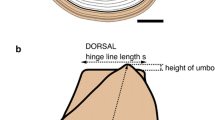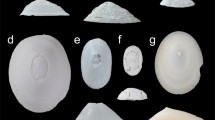Abstract
Dispersal is essential in order that endemic species living in ephemeral, patchy vent environments may persist over evolutionary time. Quantitative field studies of larval dispersal, however, require specieslevel identification of the larval forms because each individual must be distinguished from related vent species, and from non-vent species living in the surrounding deep-sea environment. Methods for culturing these larvae to an identifiable stage have not yet been developed. To solve the larval identification problem for the archaeogastropod molluscs (a prominent component of vent communities), we used a scanning electron microscope (SEM) to image shells of larvae collected in the water column near vents along the East Pacific Rise (9°40′ to 9°50′N; 104°W). Larval shell size, shape and ornamentation were compared to protoconchs retained in juvenile or adult shells of identified species, and used to assign five larval groups unequivocally to species (Cyathermia naticoides Warén and Bouchet, 1989; Neomphalus fretterae McLean, 1981; Clypeosectus delectus McLean, 1989; Rhynchopelta concentrica McLean, 1989; and Lirapex granularis Warén and Bouchet, 1989) and seven groups tentatively to species or genus [Lepetodrilus spp. (three groups); Gorgoleptis sp; Peltospira ?operculata McLean, 1989; and ?Melanodrymia sp. (two groups)].
Similar content being viewed by others
References
Berg CJ, Van Dover CL (1987) Benthopelagic macrozooplankton communities at and near deep-sea hydrothermal vents in the eastern Pacific Ocean and the Gulf of California. Deep-Sea Res 43: 379–401
Coffroth MA, Mulawka JM III (1995) Identification of marine invertebrate larvae by means of PCR-RAPD species-specific markers. Limnol Oceanogr 40: 181–189
Gustafson RG, Littlewood DTJ, Lutz RA (1991) Gastropod egg capsules and their contents from deep-sea hydrothermal vent environments. Biol Bull mar biol lab, Woods Hole 180: 34–55
Gustafson RG, Lutz RA (1994) Molluscan life history traits at deep-sea hydrothermal vents and cold methane/sulfide seeps. In: Young CM, Eckelbarger KJ (eds) Reproduction, larval biology and recruitment of the deep-sea benthos. Columbia University Press, New York, pp 76–97
Haymon RM, Fornari DJ, Von Damm KL, Lilley MD, Perfit MR, Edmond JM, Shanks III WC, Lutz RA, Grebmeier JM, Carbotte S, Wright D, McLaughlin E, Smith M, Beedle N, Olson E (1993) Volcanic eruption of the mid-ocean ridge along the East Pacific Rise crest at 9°45–52′N: direct submersible observations of seafloor phenomena associated with an eruption event in April, 1991. Earth planet Sci Lett 119: 85–101
Hessler RR, Smithey WM, Boudrias MA, Keller CH, Lutz RA, Childress JJ (1988) Temporal change in megafauna at the Rose Garden hydrothermal vent (Galápagos Rift; eastern tropical Pacific). Deep-Sea Res 35: 1681–1709
Jablonski D, Lutz RA (1983) Larval ecology of marine benthic invertebrates: paleobiological implications. Biol Rev 58: 21–89
Kim SL, Mullineaux LS, Helfrich KR (1994) Larval dispersal via entrainment into hydrothermal vent plumes. J geophys Res 99: 12655–12665
Lutz RA, Bouchet P, Jablonski D, Turner RD, Warén A (1986) Larval ecology of molluscs at deep-sea hydrothermal vents. Am malac Bull 4: 49–54
Lutz RA, Shank TM, Fornari DJ, Haymon RM, Lilley MD, Von Damm K, Désbruyeres D (1994) Rapid growth at deep-sea vents. Nature, Lond 371: 663–664
Macdonald KC (1982) Mid-ocean ridges: fine scale tectonic, volcanic and hydrothermal processes within the plate boundary zone. A Rev Earth planet Sciences 10: 155–190
McLean JH (1981) The Galapagos Rift limpet Neomphalus: relevance to understanding the evolution of a major Paleozoic-Mesozoic radiation. Malacologia 21: 291–336
McLean JH (1988) New archaeogastropod limpets from hydrothermal vents. Superfamily Lepetodrilacea. Part 1. Systematic descriptions. Phil Trans R Soc (Ser B) 319: 1–32
McLean JH (1989a) New slit limpets (Scissurellacea and Fissurellacea) from hydrothermal vents. Part 1. Systematic descriptions and comparisons based on shell and radular characteristics. Contr Sci 407: 1–29
McLean JH (1989b) New archaeogastropod limpets from hydrothermal vents: new family Peltospiridae, new superfamily Peltospiracea. Zoologica Scr 18: 49–66
McLean JH (1990) Neolepetopsidae, a new docoglossate limpet family from hydrothermal vents and its relevance to patellogastropod evolution. J Zool, Lond 222: 485–528
McLean JH (1993) New species and records of Lepetodrilus (Vetigastropoda: Lepetodrilidae) in the hydrothermal vent habitat. Veliger 36: 27–35
Mullineaux LS, Wiebe PH, Baker ET (1995) Larvae of benthic invertebrates in hydrothermal vent plumes over Juan de Fuca Ridge. Mar Biol 122: 585–596
Okutani T, Fujikura K, Sasaki T (1993) New taxa and new distribution records of deepsea gastropods collected from or near the chemosynthetic communities in the Japanese waters. Bull natn Sci Mus, Tokyo (Ser A) 19: 123–143
Olson RR, Runstadler JA, Kocher TD (1991) Whose larvae? Nature, Lond 351: 357–358
Powell AWB (1942) The New Zealand Recent and fossil Mollusca of the family Turridae. Bull Auckland Inst Mus 2: 1–188
Scheltema RS (1962) Pelagic larvae of New England intertidal gastropods. I. Nassarius obsoletus and Nassarius vibex. Trans Am microsc Soc 81: 1–11
Tunnicliffe V (1991) The biology of hydrothermal vents: ecology and evolution. Oceanogr mar Biol A Rev 29: 319–407
Turner RD, Lutz RA, Jablonski D (1985) Modes of molluscan larval development at deep-sea hydrothermal vents. Bull biol Soc Wash 6: 167–184
Van Aartsen JJ, Bogi C, Giusti F (1989) Remarks on genus Benthonella (Rissoidae) in Europe and the description of Laeviphitus (nov. gen) verduini (nov. spec.) (Epitoniidae). Conchiglie (Un malac ital, Milano). 21: 19–22
Warén A, Bouchet P (1986) Four new species of Provanna Dall (Prosobranchia, Cerithiacea?) from East Pacific hydrothermal sites. Zoologica Ser 15: 157–164
Warén A, Bouchet P (1989) New gastropods from East Pacific hydrothermal vents. Zoologica Scr 18: 67–102
Warén A, Bouchet P (1993) New records, species, genera, and a new family of gastropods from hydrothermal vents and hydrocarbon seeps. Zoologica Scr 22: 1–90
Warén A, Carrozza F, Rocchini R (1990) Elachisina versiliensis, a new Mediterranean species of the family Elachisinidae (Prosobranchia, Trucatelloidea). Boll Malac (Milano) 25: 335–339
Warén A, Ponder WF (1991) New species, anatomy, and systematic position of the hydrothermal vent and hydrocarbon seep gastropod family Provannidae fam.n. (Caenogastropoda). Zoologica Scr 20: 27–56
Wiebe PH, Copley N, Van Dover CL, Tamse A, Manrique F (1988) Deep-water zooplankton of the Guaymas Basin hydrothermal vent field. Deep-Sea Res 35: 985–1013
Author information
Authors and Affiliations
Additional information
Communicated by N.H. Marcus, Tallahassee
Rights and permissions
About this article
Cite this article
Mullineaux, L.S., Kim, S.L., Pooley, A. et al. Identification of archaeogastropod larvae from a hydrothermal vent community. Marine Biology 124, 551–560 (1996). https://doi.org/10.1007/BF00351036
Received:
Accepted:
Issue Date:
DOI: https://doi.org/10.1007/BF00351036




